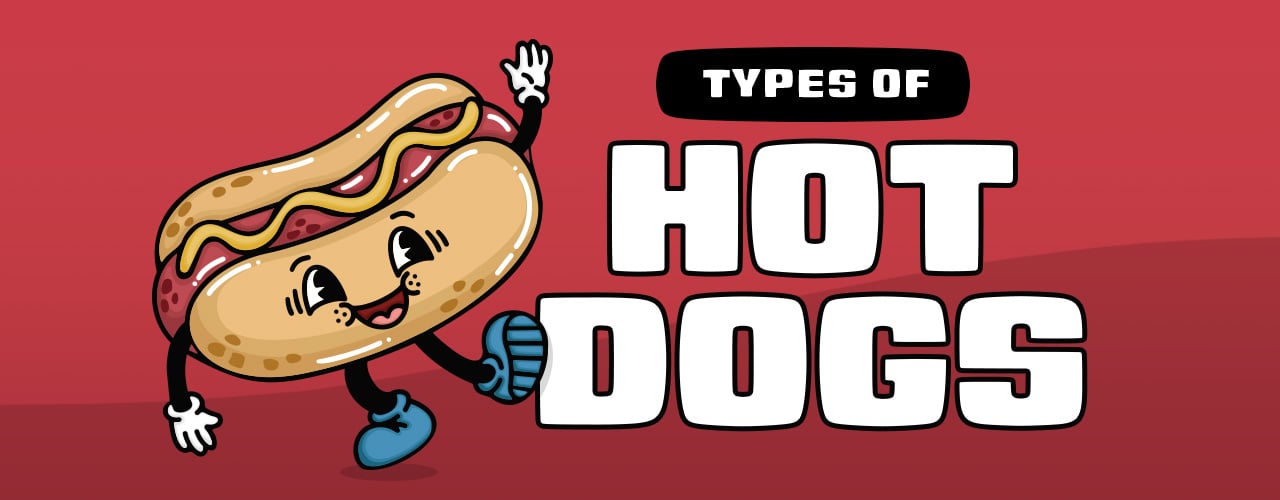During the Great Depression, the hot dog emerged as a quintessential American food, symbolizing convenience, affordability, and a taste of tradition all in one bite. President Franklin D. Roosevelt served this humble yet beloved sausage sandwich at the White House to the visiting King of England, George VI. This iconic moment solidified the hot dog's place in American culinary history. Not only is it a storied food, but with the rise of inflation and economic uncertainty, the hot dog is making a resurgence. Like the different types of American BBQ, hot dogs are diverse. There are countless regional variations of the hot dog, with different parts of the country building a unique dish on the base of sausage and bun.
Shop All Hot Dogs- 1. New York Style Hot Dog
- 2. Corn Dog
- 3. Chicago Dog
- 4. Coney Island Hot Dog
- 5. Puka Dog
- 6. Maxwell Street Polish
- 7. Sonoran Dog
- 8. Dodger Dog
- 9. Italian Dog
- 10. Polish Boy
- 11. Hot Dog FAQ
Regional Hot Dogs
Take a trip across the United States to explore the diverse regional varieties of hot dogs. Whether you find yourself strolling through the bustling streets of Chicago or relaxing at beachside concession stands in Hawaii, each town offers its own distinctive and delicious hot dog creations.
Hot Dog Styles
America boasts a wide range of regional hot dog styles. From universally beloved corn dogs and famed Chicago dogs to niche regional styles like the Sonoran or Puka dogs, we provide a list of the top ten hot dogs in America.
1. New York Style Hot Dog

New York City is famous for its diverse culinary scene, and one iconic street food synonymous with the city is the New York-style hot dog. The key components of a New York-style hot dog are a boiled beef frankfurter served on a soft bun and topped with a generous helping of spicy brown mustard, sauerkraut, and onion sauce. Onion sauce is made by sauteing onions in oil, tomato paste (or ketchup), and spices, creating a savory and slightly sweet contrast to the zesty brown mustard. Some vendors also offer additional toppings such as relish, ketchup, or even spicy chili to cater to different preferences. New York-style hot dogs are often served in a paper tray or wrapped in foil for easy handling, accommodating the bustling lifestyle of The City That Never Sleeps.
It’s believed that the first hot dogs were born out of New York. In the 1860s, German immigrants started selling sausages on milk rolls with sauerkraut from carts in New York City’s Bowery. These sausage sandwiches were known as Red-Hot Dachshund Sausages. By 1867, a German immigrant and baker named Charles Feltman began selling hot dogs in Coney Island, New York. He served his sausages on a long, sliced bun so beachgoers could enjoy their lunch on the sand. Feltman sold 3,600 hot dogs his first year of operation, and America’s love of hot dogs was born. In recent years, The National Hot Dog and Sausage Council estimated that New Yorkers spend over $120 million a year on franks, proving the New York-style hot dog is still a beloved staple in the city's culinary landscape.
- Dog: Boiled all-beef frank
- Bun: Steamed white bun
- Toppings: Spicy brown mustard, sauerkraut, onion sauce
2. Corn Dog

Not just a regional food, corn dogs are a popular choice across America. The key components of a corn dog are a hot dog that is skewered on a stick, coated in a thick layer of cornmeal batter, and deep-fried until golden brown. The hot dog provides a meaty center, while the cornmeal batter adds a crunchy exterior. The batter typically consists of cornmeal, flour, sugar, baking powder, and seasonings, creating a sweet and savory flavor profile. To make a corn dog, the hot dog is first skewered onto a stick for easy handling. It’s then dipped into the cornmeal batter, carefully placed into a high-heat oil, and deep fried. The oil cooks the hot dog inside while creating a crispy golden crust on the outside. Once cooked to perfection, the corn dog is ready to be enjoyed on its own or with condiments like mustard or ketchup. Drizzle your hand-dipped corn dogs with homemade hot honey to elevate your menu and play into the swicy trend.
Scores of food entrepreneurs lay claim to the corn dog’s invention. Many believe it was German immigrants to Texas who first created the corn dog, combining their time-honored sausage-making traditions with the beloved cornbread found in the American South. In 1942, brothers and Vaudeville performers, Neil and Carl Fletcher, started selling “corny dogs” at the Texas state fair, popularizing this now beloved food. However, some contest that the title of corn dog inventor and propagator belongs to a diner in Oregon called Pronto Pup since they started selling their cornmeal-batted hot dogs as early as 1941. Co-founder of the Cozy Dog Drive-In, Ed Waldmire, claims to have perfected the recipe with his future business partner Don Strand after trying a hot dog baked into cornbread at an Oklahoma diner in 1941. Regardless of who popularized it, corn dogs are a beloved food across the United States enjoyed at carnivals, fairs, and concession stands.
- Dog: Beef and pork blend hot dog
- Other Ingredients: Cornmeal batter, deep frying oil, stick
- Condiments: Mustard, ketchup, hot honey
3. Chicago Dog
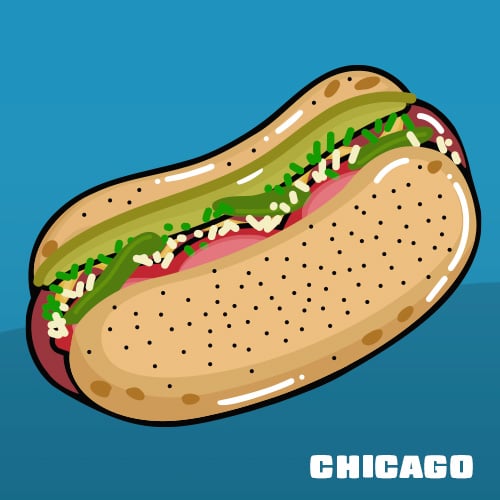
The Chicago dog, also known as the Chicago-style hot dog, is a beloved classic in the world of franks. This iconic “dragged through the garden” hot dog is synonymous with the vibrant food culture of Chicago, Illinois. A traditional Chicago dog starts with an all-beef hot dog served in a poppy seed bun. Its smorgasbord of toppings sets it apart. It’s loaded with bright green sweet pickle relish, a dill pickle spear, tomato slices, pickled sport peppers, yellow mustard, chopped white onions, and a dash of celery salt. These toppings come together to create a flavor profile that is at once tangy, savory, and sweet.
The origins of the Chicago dog can be traced back to the 1930s Great Depression era. Fluky’s started marketing their “Depression Sandwich” (which we now know as the Chicago dog) in 1929 for a nickel each. All the toppings provided bulk and nutrients to the simple and affordable meal. Aside from the toppings, Chicago dogs are set apart by their all-beef Vienna Beef dogs popularized by Jewish immigrants to Chicago. The Chicago’s Union Stockyards had notoriously low health and hygiene standards, and the Jewish community's all-beef dogs offered an alternative to the pork sausages made at the Stockyards. Over the years, the Chicago dog has become a staple of the city's culinary scene and is a must-try for hot dog enthusiasts visiting the Windy City.
- Dog: Boiled or steamed all-beef frankfurter (traditionally Vienna Beef)
- Bun: Poppy seed bun
- Toppings: Bright green sweet pickle relish, a dill pickle spear, tomato slices, pickled sport peppers, yellow mustard, chopped white onions, celery salt
4. Coney Island Hot Dog

Coney Island hot dogs consist of a grilled beef frankfurter in a natural casing placed in a soft, steamed bun. It's then topped with a flavorful all-meat chili sauce (“Coney sauce”), yellow mustard, and chopped, raw onions. Some variations may also include additional toppings, such as pickles, jalapenos, or cheddar cheese. Hot dog enthusiasts used the term “Coneys” as shorthand for the beloved food, but it can also signify the type of restaurants where Coney Island dogs are served. In Detroit, “Coney Islands” are Greek-American diners that serve Coney dogs alongside other staples such as gyros, Greek salads, burgers, and breakfast foods.
Despite its name, the Coney Island hot dog didn’t originate in Coney Island, New York. The story of the Coney Island hot dogs began in the early 20th century when Greek immigrants came through New York’s Ellis Island and encountered hot dogs on Coney Island. After making their way further west to Detroit, Michigan, these immigrants introduced their twist to the classic hot dog by adding a savory meat chili sauce, and the Coney dog was born. Over the years, the Coney Island hot dog has spread nationwide. Today, you can find variations of the Coney Island dog at food carts, trucks, and trailers throughout the United States, each offering a unique take on this flavorful and satisfying street food favorite.
- Dog: Grilled all-beef frankfurter in natural casing
- Bun: Steamed hot dog bun
- Toppings: All meat chili sauce, yellow mustard, chopped raw onions
5. Puka Dog
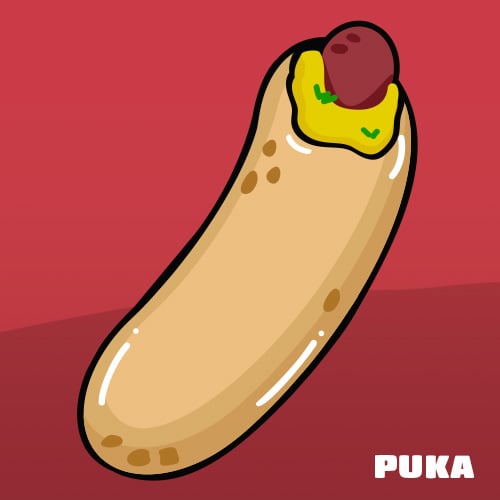
Originating in Hawaii, Puka dogs, also known as Hula Dogs, are a unique and tropical twist on the classic hot dog. This specialty hot dog features a Hawaiian sweet bread bun with a hole in its center. Chefs create the hole by inserting a heating rod into the bun. This also toasts the inside of the bun. They then stuff the hole with a high-quality grilled Polish sausage, adding a rich and meaty flavor to the dish. Traditional condiments include mango or passion fruit mustard, spicy garlic citrus sauce, and tropical fruit relish. The Hula dog offers a harmonious blend of sweet, tangy, and spicy flavors.
Puka dogs emerged out of a small hot dog hut at the base of the Waimea Canyon in Kauai. The name "puka" comes from the Hawaiian word for "hole", referring to the hole in the bun where the sausage is placed. Inspired by their tropical surroundings, the owners began creating exotic relishes and sauces from the native fruits and plants of Kauai. Popular relish flavors are mango, pineapple, and coconut. The combination of savory sausage and spicy sauce with the sweet relish and bun makes puka dogs an ambrosial food. Create your own version of the trademarked puka dog and invite guests to an island experience at your mainland establishment.
- Dog: Grilled Polish sausage
- Bun: Hawaiian sweet bread bun
- Toppings: Tropical fruit relish, mango mustard, spicy citrus garlic sauce
6. Maxwell Street Polish

The “Chicago Dog” isn’t the Windy City’s only famous frank; The Maxwell Street Polish is another beloved hot dog variation from Chicago. This iconic dog is named after Maxwell Street, a historic market street in Chicago known for its vibrant atmosphere and diverse culinary offerings. It typically consists of a grilled Polish sausage served on a bun with yellow mustard, fried onions, and sport peppers. This type of Polish sausage is a flavorful and slightly spicy smoked variety that is a staple in Polish cuisine.
The Maxwell Street Polish dog was created by Jim’s Original in 1939. Back then, Jim’s original was a stand in Chicago’s historical Maxwell Street Market, run by Yugoslavian-born founder Jimmy Stefanovic. Whether you're exploring the bustling streets of Chicago or looking to add a unique and flavorful hot dog option to enhance your happy hour, the Maxwell Street Polish is a classic choice that never fails to impress with its bold and satisfying taste.
- Dog: Grilled, smoked pork and beef Polish sausage
- Bun: Plain hot dog bun
- Toppings: Fried onions, sport peppers, yellow mustard
7. Sonoran Dog
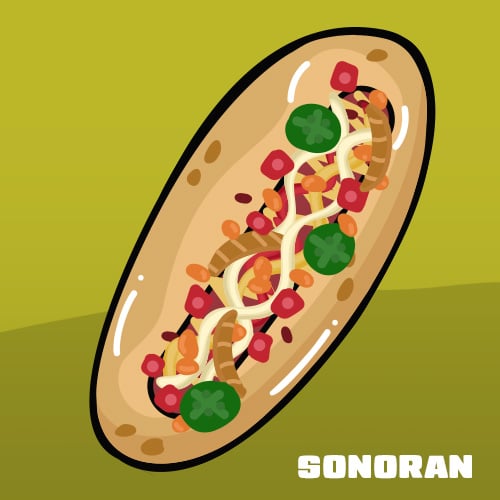
Originating from the Sonora region of Mexico in the early 1970s, the Sonoran dog is a bacon-wrapped, beef hot dog nestled in a soft, slightly sweet bolillo-style bun. The bun is topped with a variety of indulgent condiments, including pinto beans, grilled onions, chopped tomatoes, mustard, mayonnaise, and jalapenos. This combination of ingredients creates a mouthwatering blend of textures and flavors. It has gained a cult following in the United States, particularly in the Southwestern states of Arizona and Texas. Tucson, Arizona, even created a Sonoran hot dog trail to help visitors and locals sample Sonoran dogs from a diverse array of businesses.
One of the defining features of a Sonoran dog is its bolillo-style bun. Originating from Mexico, these buns are characterized by a soft interior encased in a crusty exterior. They’re made from a simple dough of flour, water, yeast, and salt. A Mexican variation of the baguette, bolillos are typically shorter and thicker than traditional hot dog buns and are shaped into an elongated oval before they’re baked. Of course, it’s the generous toppings that elevate the Sonoran dog from a snack to a hearty meal. While the traditional Sonoran dog follows a specific recipe, there are regional variations that add a unique twist to this Mexican-inspired dish. Some versions may include queso, cotija, or guacamole, and offer different types of salsas as garnishment.
- Dog: Grilled, all-beef hot dog wrapped in bacon
- Bun: Bolillo
- Toppings: Pinto beans, grilled onions, chopped tomatoes, mustard, mayonnaise, jalapeno
8. Dodger Dog
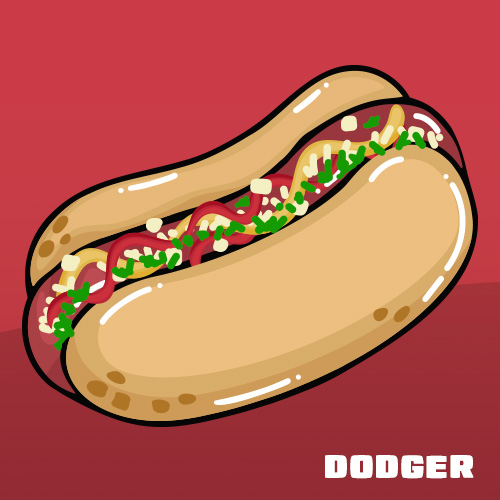
Dodger Dogs are grilled or steamed pork wieners in soft, steamed hot dog buns topped with classic condiments such as mustard, ketchup, onions, and relish. Named after the Los Angeles Dodgers, they are made remarkable by their 10-inch length (the average hot dog is 6 inches). The grilled variety is considered the traditional version and was known as “Farmer John Dodger Dogs” until 2021. There are a few variations of Dodger Dogs. The Super Dodger Dog is made with 100% beef sausage, and the Doyer Dog replaces the traditional toppings with chili, salsa, and jalapenos.
Sold at their namesake stadium, these iconic hot dogs are a staple at baseball games and have a rich history that dates back several decades. They received their name in 1958 when the Dodgers moved from Brooklyn to Los Angeles, and the Dodger Dog has been a fan favorite at Dodger Stadium ever since. Dodger Dogs consistently lead hot dog sales at all Major League Baseball ballparks. The hot dogs are supplied by California-based Papa Cantella’s. Outside of the Dodger Stadium, you can purchase Dodger Dogs at a small chain of restaurants throughout Southern California. They make an excellent addition to any sports bar marketing strategy.
- Dog: Grilled or steamed 10-inch pork hot dog
- Bun: Steamed hot dog bun
- Toppings: Mustard, ketchup, onions, relish
9. Italian Dog
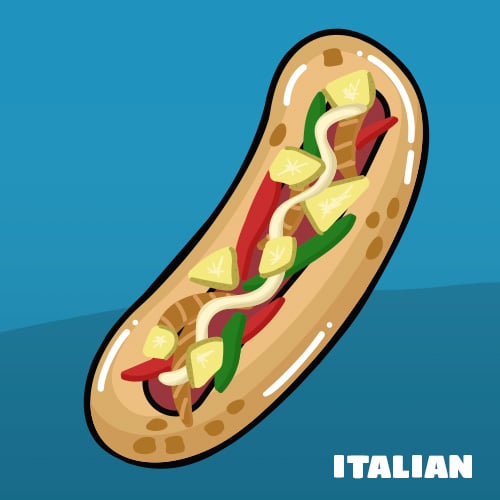
Originating in Newark, New Jersey, the Italian hot dog is a beloved classic throughout the state. It starts with one or two spicy (aka single or double), all-beef hot dogs and is loaded with flattop fried potatoes, peppers, and onions. To complement its savory flavors, the Italian hot dog is generously drizzled in spicy brown mustard, adding a tangy kick. It’s traditionally served on pizza bread; leftover pizza dough shaped into circular pockets like pita. Pizza bread has an airy but chewy bite, serving as a sturdy yet pillowy base for these hearty frankfurters.
Jimmy “Bluff” Racioppi and his wife, Mary Racioppi, introduced the Italian dog to the culinary scene. Jimmy was nicknamed “Jimmy the Buff” for his habit of bluffing when he played poker. When Mary created the now beloved Italian hot dogs in 1932, it was such a hit with Jimmy and his poker buddies that the couple decided to open their restaurant, “Jimmy Buffs” in Newark, New Jersey, to share their delicious sausage sandwiches. Italian hot dogs are now popular throughout New Jersey. As more and more establishments started preparing and serving Italian hot dogs, some chose to use sandwich loaves instead of pizza bread. However, a truly authentic Italian hot dog distinguishes itself by its pizza bread bun.
- Dog: Spicy, all-beef hot dogs (traditionally from Best Provisions in Newark, NJ)
- Bun: Pizza bread
- Toppings: Flattop grilled potatoes, peppers, and onions, deli mustard
10. Polish Boy
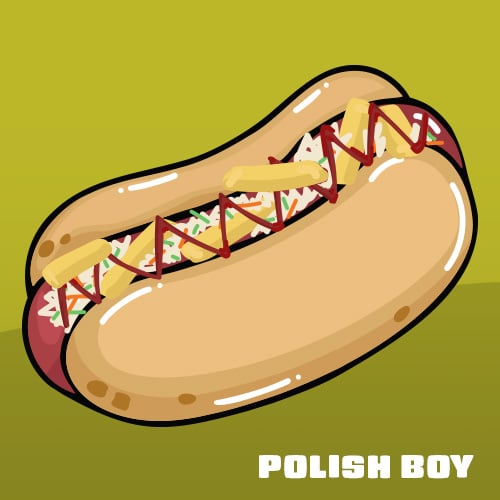
Originating from Cleveland, Ohio, a Polish Boy hot dog is a grilled or deep-fried smoked kielbasa in a barbeque sauce-coated hoagie roll piled with mounds of coleslaw and French fries. The correct order for assembling a Polish boy is to grill or pan-fry the kielbasa, toast the bun, and then place the sausage inside. To layer the toppings, squeeze a stream of BBQ sauce onto the kielbasa, load in some fries, and then place a pile of slaw on top. This combination of savory and tangy flavors creates a delicious and satisfying meal that has become a favorite among food enthusiasts and makes the perfect Fourth of July menu item.
The origins of the Polish Boy hot dog can be traced back to the 1940s when it was first introduced by local Cleveland food vendors looking to create a unique and affordable street food option. A true Cleveland’s Own menu item, the kielbasa gives a nod to Eastern Europe’s influence on Northeast Ohio. Over the years, variations of the Polish Boy have popped up in food trucks, diners, and BBQ joints nationwide. Some variations favor vinegar-based slaw to creamy slaw, some establishments sub perogies for fries, and BBQ restaurants add pulled pork or chopped brisket to the already hefty sandwich.
- Dog: Grilled or deep-fried smoked kielbasa
- Bun: Hoagie bun
- Toppings: Coleslaw, French fries, BBQ sauce
Hot Dog FAQ
Now that you know the top ten types of regional hot dogs, you might have some questions about the hot dog ingredients behind each creation. We answer some of the most frequently asked hot dog questions below, so you can create a delicious dog-eating experience at your establishment.

What Are Hot Dogs Made Of?
At its core, a hot dog is a type of sausage, traditionally a Vienna sausage or a frankfurter, that is typically made from a mixture of finely ground meat, food starch, flavorings, corn syrup, and water. The most common meats used in hot dogs include beef, pork, and chicken, but there are also variations made with turkey, veal, or a combination of different meats. One key characteristic of hot dogs is their casing, which is the thin, edible membrane that encases the meat mixture. Casings can be natural (made from animal intestines), or synthetic (made from materials like collagen or cellulose). The casing is what gives hot dogs their signature snap when bitten into.
Hot dogs can be found in various forms, including fresh, smoked, or cured. Fresh hot dogs are uncooked and must be cooked before consumption, while smoked and cured hot dogs are pre-cooked and can be eaten cold or heated up. Additionally, hot dogs come in different shapes and sizes, from the classic long and skinny frankfurter to the shorter and thicker cocktail franks. They range in flavor from mild and savory to bold and spicy, depending on the seasonings and spices used in the meat mixture. Some hot dogs may also contain additional ingredients like cheese, jalapenos, or bacon bits to add extra flavor and texture.
What Is the Difference between Hot Dogs and Sausages?
Hot dogs are a type of sausage. The term sausage categorizes ground meat mixed with spices and salt, which is then stuffed into a casing. Fat content and texture distinguish hot dogs from other sausages. While hot dogs are finely ground and typically have a lower fat content, most sausages have a higher fat content and are not as finely ground. Because they typically contain artificial flavorings and corn syrup, hot dogs are considered less healthy than other sausage varieties made with more natural ingredients.
Back to TopHot dogs are a beloved classic in American cuisine, and their popularity is undeniable. It’s estimated that over 7 billion wieners are consumed nationwide during Hot Dog Season (the months between Memorial Day and Labor Day). Consider adding a few of the regional hog dog styles listed above to your summer menu to attract new customers. With so many different types of hot dogs available, this versatile menu item can be reimaged time and again to broaden your customer base.
